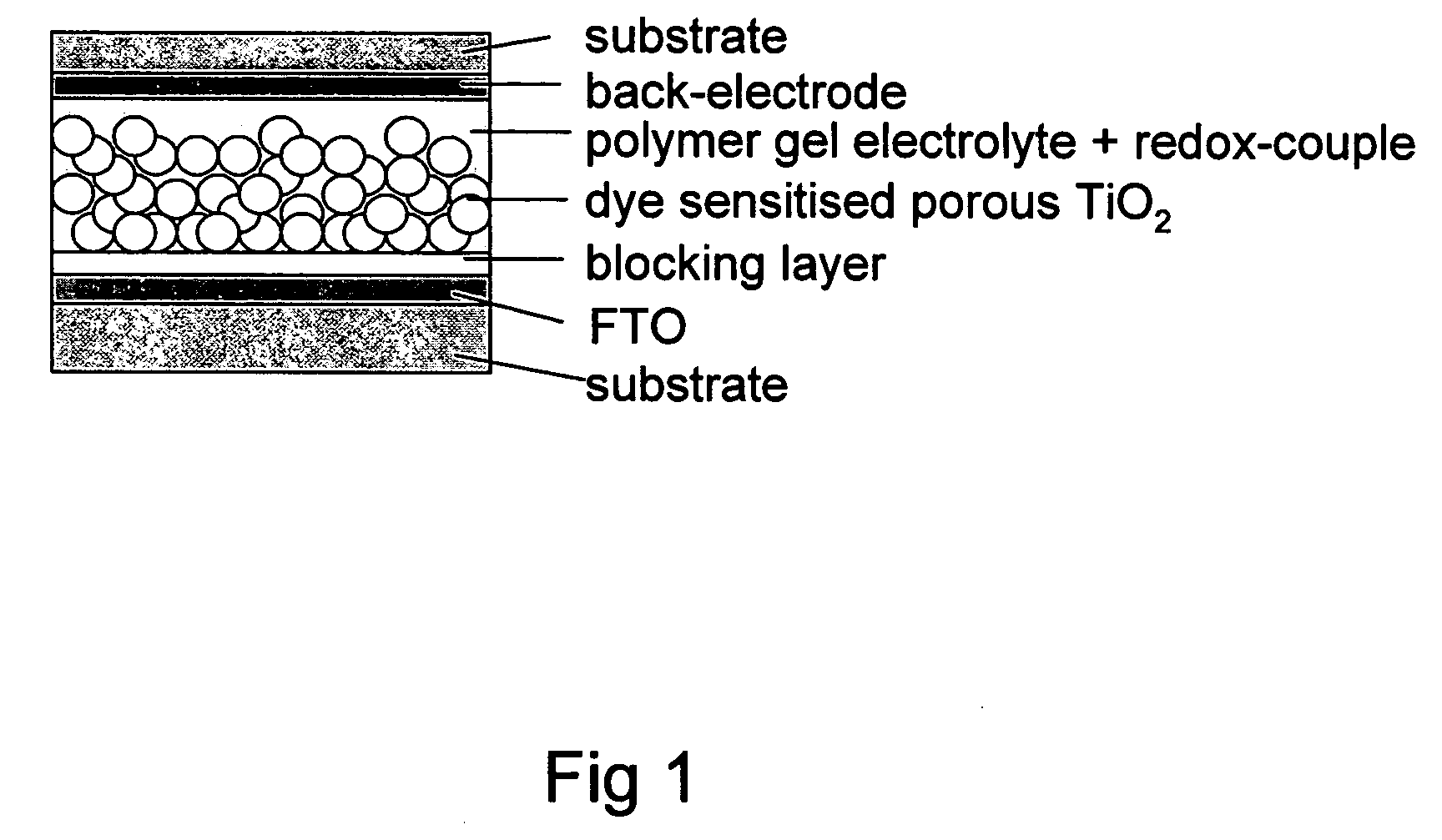Polymer gel hybrid solar cell
a solar cell and polymer gel technology, applied in the field of polymer gel hybrid solar cells, can solve the problems of limiting the nature of components and polymerisation techniques, unable to form many gels in the presence of iodine, and high manufacturing costs of solar cells based on si, and achieves high energy conversion efficiency
- Summary
- Abstract
- Description
- Claims
- Application Information
AI Technical Summary
Benefits of technology
Problems solved by technology
Method used
Image
Examples
example 1
[0052] In one example, polyethylene oxide [PEO, Mw 400.000] was used in ethylene carbonate [EC] / propylene carbonate [PC] mixture filled with lithium iodide / iodine [LiI / I2] and an inert Li salt. In PEO polymer gel electrolyte, the solid polymer matrix of PEO provides dimensional stability to the electrolyte, while the high permittivity of the solvents PC and EC enables extensive dissociation of the Li salts to take place. The low viscosity of PC and EC provides an ionic environment that facilitates high ionic mobility. Such polymer gel electrolytes exhibits high ionic conductivities in excess of 103 S / cm.
example 2
[0053] Solar Cell Preparation
[0054] Blocking Layer
[0055] Made by spray pyrolysis: spraying with an atomiser an aerosol dispersion of an organic precursor titanium acetylacetonate (TAA, Aldrich) in ethanol (concentration of 0.2 M) onto structured FTO coated glass substrates (at 450° C.) (Geomatic). To get a thin, amorphous, compact layer of TiO2 (about 30 nm), films are tempered at 500° C. in air for 1 hour.
[0056] Nanocrystalline TiO2 Electrode+Dye Layer
[0057] Porous TiO2 layers are made by screen printing of a paste containing TiO2 particle of 10 nm or 20 nm diameter respectively (Solaronix Company) on top of the blocking TiO2 layer (thickness depends on mesh size of screens). To get rid of the organic solvents and surfacatants, and to enable a contact between TiO2 particles, porous TiO2 layers are heated up to 85° C. for 30 minutes in a first step and sintered at 450° C. for ½ hour. After cooling down to 80° C., films are placed into a dye solution in ethanol (5×10−4 M) and sta...
example 3
[0069] The photovoltaic cell is fabricated by drop casting the ready made gel electrolyte on top of the dye-sensitised porous TiO2 coated electrode, and sandwiched with a platinum back-electrode.
[0070] The layer thickness of the nanocrystalline TiO2, is varied in the range of 2 to 20 μm, containing particles of 10 or 20 nm in diameter. The illuminated area of the cell is ca. 0.5-0.6 cm2. As sensitizer dye cis-di(thiocyanato) bis (2,2′-bipyridyl-4,4′-dicarboxylate) ruthenium (II) tetrabutylammonium (Ru(bpy)TBA) is used.
[0071] The electron transfer and transport processes in the cell are schematically shown in FIG. 2. Light absorbed by the dye molecules injects electrons in to TiO2 (t−10-12 s) and holes into the Li / I2 system (t−10−8 s). At the Pt back-electrode, the resulting I3− species will be reduced to I−, undergoing the following redox reactions [D. Kuciauskas, M. S. Freund, H. B. Gray, J. R. Winkler, and N. S. Lewis, J. Phys. Chem. B 105 (2001) 392][0072] 1) Ru(II)+hv→Ru(II)+[...
PUM
 Login to View More
Login to View More Abstract
Description
Claims
Application Information
 Login to View More
Login to View More - R&D
- Intellectual Property
- Life Sciences
- Materials
- Tech Scout
- Unparalleled Data Quality
- Higher Quality Content
- 60% Fewer Hallucinations
Browse by: Latest US Patents, China's latest patents, Technical Efficacy Thesaurus, Application Domain, Technology Topic, Popular Technical Reports.
© 2025 PatSnap. All rights reserved.Legal|Privacy policy|Modern Slavery Act Transparency Statement|Sitemap|About US| Contact US: help@patsnap.com



